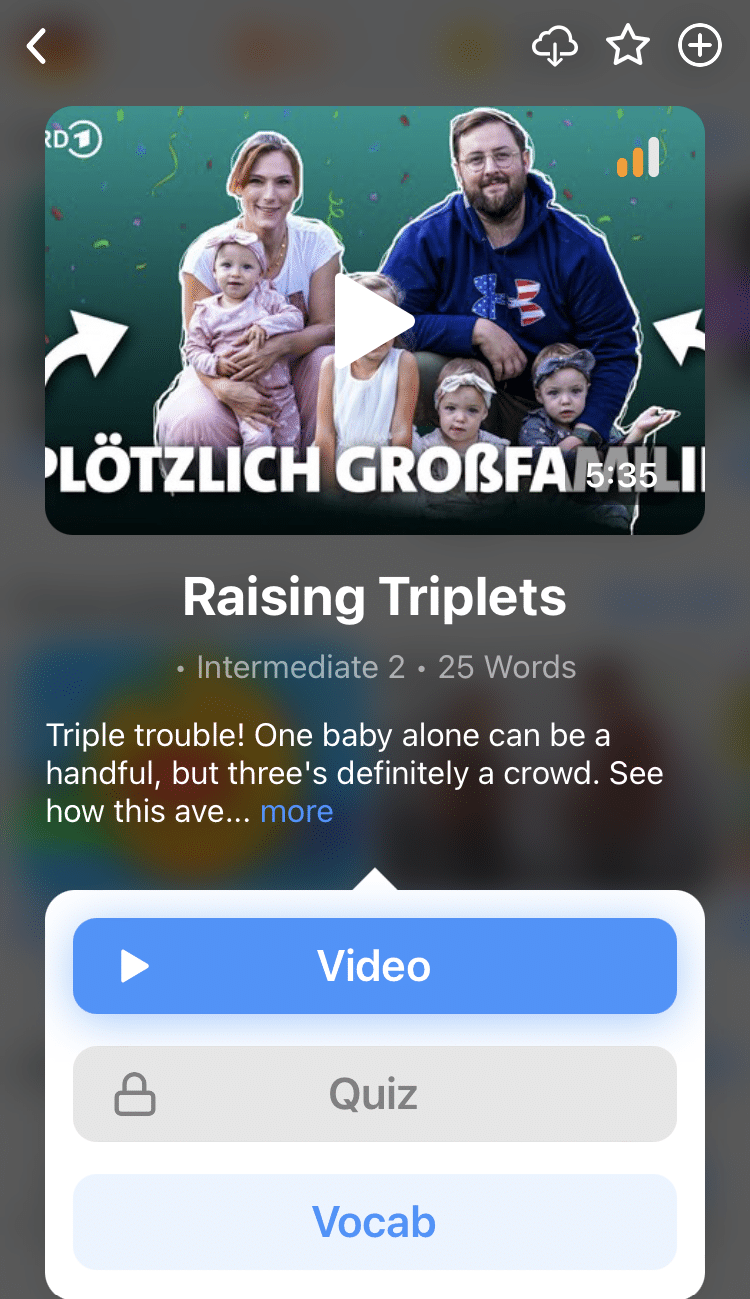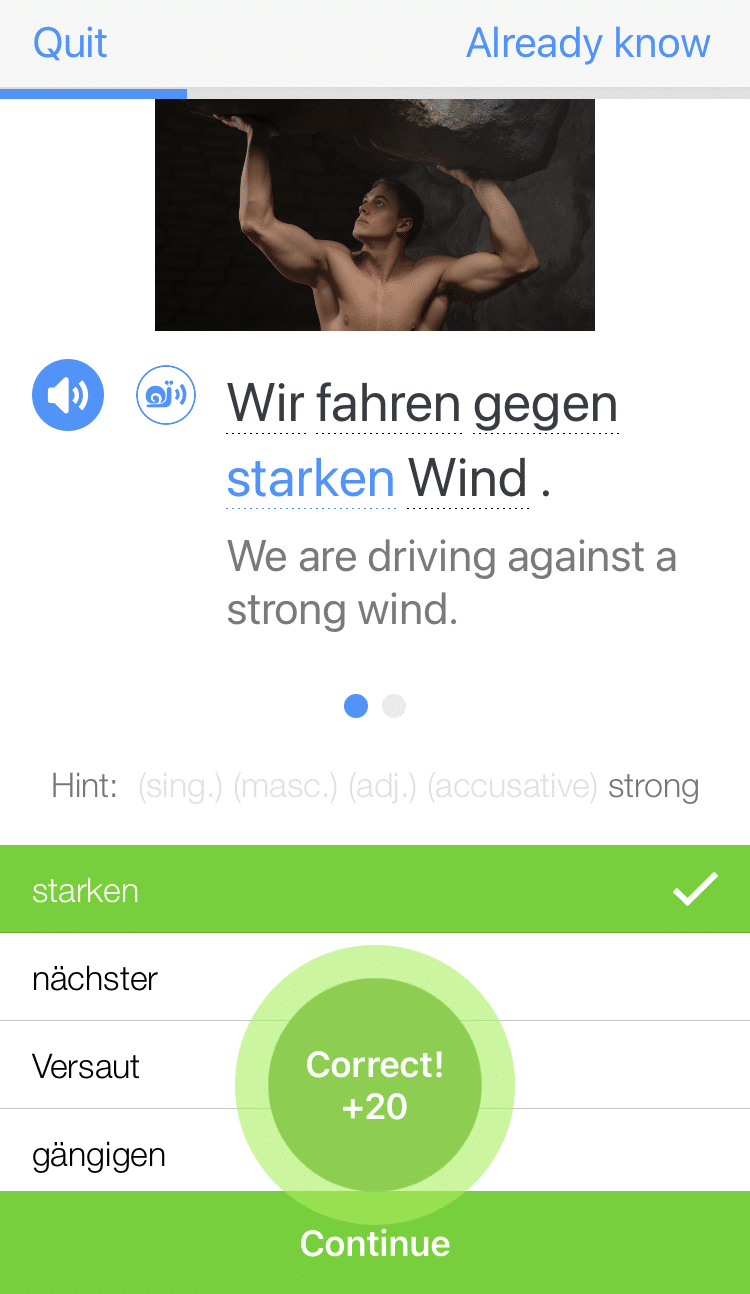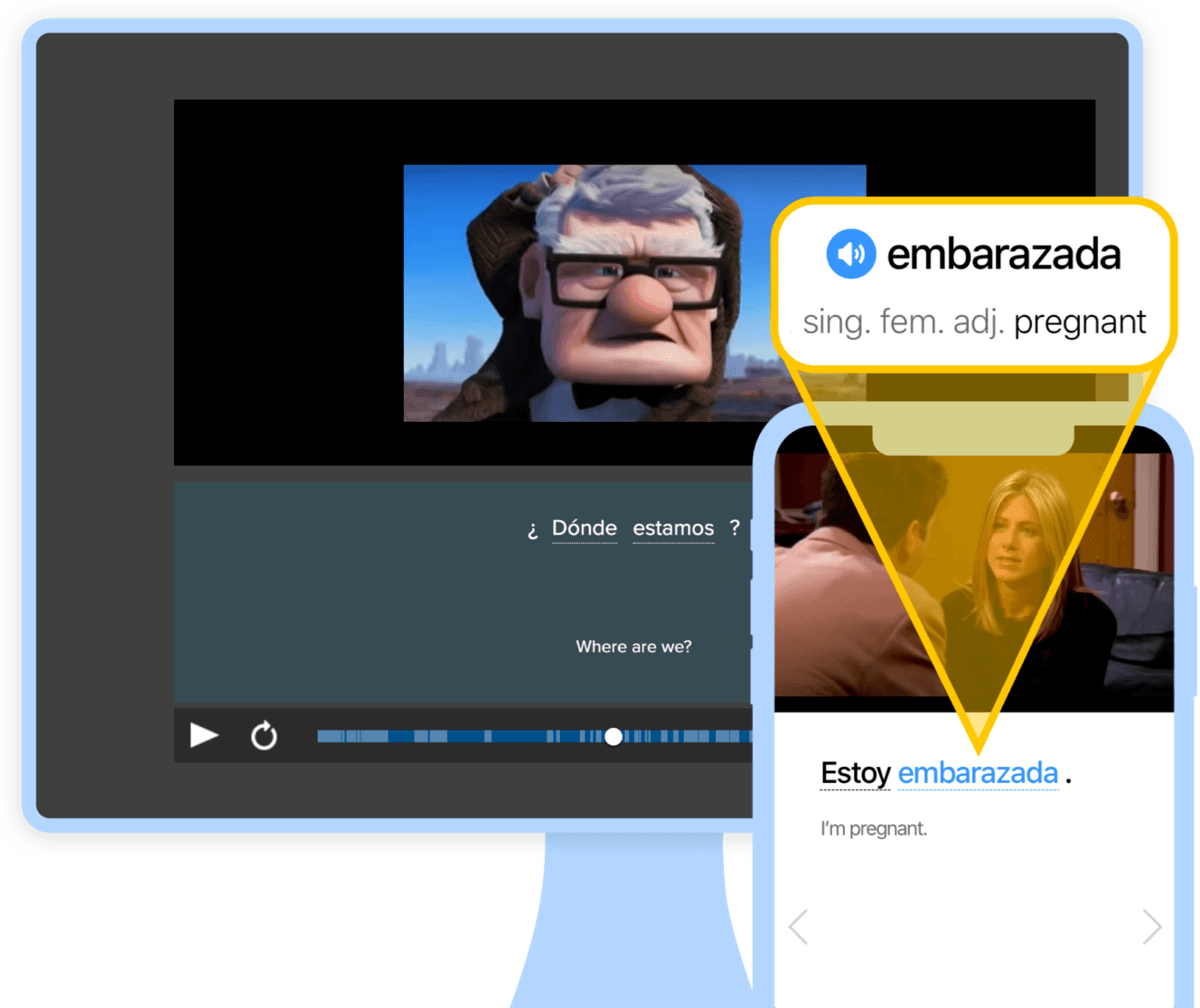
German Sentence Structure: The Simple Guide to German Word Order
As a German learner, you might feel that anything other than the simplest of sentences requires some serious forethought.
While learning German grammar does involve some classic textbook-style work and memorization, it doesn’t always transfer smoothly to forming sentences on your own.
In this post, we’re going to focus on the content of what we want to say, and how to say it in correct German word order.
By the end, you’ll be more comfortable with German sentence structure so you can turn your thoughts into coherent sentences!
Contents
- Basic German Word Order
- Sentences with Conjunctions
- Other German Verb Positions
- German Word Order with Adverbs
- German Sentence Structure Practice
Download: This blog post is available as a convenient and portable PDF that you can take anywhere. Click here to get a copy. (Download)
Basic German Word Order
In simple German sentences, you may see the same word order as English: Subject + Verb + Object.
Ich werfe den Ball. (I throw the ball.)
So the subject (Ich) does an action (werfe) to an object (den Ball).
However, you’ll likely see another word order as well: Object + Verb + Subject.
Den Film kenne ich nicht. (I don’t know that film.)
Here we have the object (Den Film), then the verb (kenne) and then the subject (ich nicht).
In German, it’s common to switch the Subject and Object positions in the sentence depending on the information you want to emphasize.
The most important part of German word order is that the verb will always come in the second position in the sentence:
Wir essen den Kuchen. (We’re eating the cake.)
[Subject + Verb + Object]
Das Buch lese ich. (I’m reading that book.)
[Object + Verb + Subject]
This “verb comes second” rule still very much applies if you add in a little adverb phrase to spruce up the start of your sentence. In this case, after the verb comes the subject, then the object follows:
Nächste Woche kaufen wir ein neues Auto. (Next week, we are buying a new car.)
[Adverb + Verb + Subject + Object]
Sentences with Conjunctions
Now, to add more information to your sentences, you’ll often need to use conjunctions. In German, different kinds of conjunctions have different effects on the sentence structure.
Coordinating conjunctions
Coordinating conjunctions connect two parts of a sentence of equal rank, and coordinating conjunctions do not change German word order.
Here’s a list of the most common coordinating conjunctions and example sentences (notice how each half of the sentences are in SVO order!):
| Conjunction | Example |
|---|---|
| und (and) | Ich gehe joggen und ich spiele Tennis. (I go jogging and I play tennis.) |
| oder (or) | Wir kochen zu Hause oder wir gehen ins Restaurant. (We cook at home or we go to a restaurant.) |
| aber (but) | Ich will nicht singen aber ich tanze gern! (I don't want to sing, but I like to dance!) |
| denn (because; as) | Ich trage einen Mantel, denn es ist kalt! (I'm wearing a jacket because it is cold!) |
Subordinating conjunctions
In direct opposition to the coordinating kind, subordinating conjunctions connect two parts of a sentence of different rank.
And, in German, subordinating conjunctions move the first verb in the subordinating clause to the end of that clause.
So in simple German word order, you’d say:
Er ist ein egoistischer Idiot. (He is a selfish idiot.)
Notice the verb (ist) in the second position there. However, if you add the subordinating conjunction weil (because), you’ll get:
Ich kann ihn nicht leiden, weil er ein egoistischer Idiot ist. (I can’t stand him because he’s a selfish idiot.)
See the second half of that sentence, after the comma? Notice ist all the way at the end now? That’s because of the subordinating conjunction.
See again, with obwohl (although, even though):
Obwohl er ein egoistischer Idiot ist, sollten wir nett zu ihm sein. (Even though he’s a selfish idiot, we should be nice to him.)
The most common subordinating conjunctions include weil and obwohl, as well as während (while), bis (until), bevor (before), als (when), wenn (when, if), da (as, because), ob (whether, if) and dass (that).
Other German Verb Positions
Similar to the verb placement in subordinating conjunctions, there are other situations where you’ll find the verb outside of its typical second position.
With relative clauses
For instance, with every relative clause in German, the verb comes at the end of the relative clause.
Take a look at some examples:
Kennst du die Frau, die da drüben auf der Bank sitzt? (Do you know the woman who is sat on the bench over there?)
Ihre Freunde, die sie seit Jahren kennt, sind wirklich nett. (Her friends, that she’s known for years, are really nice.)
If there are two verbs in a relative clause, the first is always the one that gets booted to the end of the sentence.
That means for past participles you’ll move the auxiliary verb: the habe in habe… geschlafen, the ist in ist… gegangen and the muss in muss… lernen, for instance.
Das ist der Typ, der deine Tasche geklaut hat! (That’s the guy who stole your bag!)
Den Film, den wir heute gesehen haben, war stinklangweilig. (The film, that we saw today, was incredibly boring.)
Hast du die Hausaufgaben, die wir morgen abgeben müssen, schon gemacht? (Have you already done the homework that we have to hand in tomorrow?)
With modal verbs
Here’s another instance in which you’ll see a verb in a different location within a German sentence. Remember that modal verbs allow for the expression of obligation or possibility.
When you use a modal verb in German, the second verb in the sentence is always in the infinitive form. The infinitive verb comes at the end of the sentence.
The German modal verbs are: dürfen (may, to be allowed to), mögen (to like, to like to), müssen (must, to have to), können (can, to be able to), wollen (will, to want to) and sollen (should, ought to).
So you know when you see one of those verbs in a sentence, you’ll find an infinitive verb at the end, like so:
Wir müssen die Hausaufgaben machen. (We need to do the homework.)
Du solltest früher ins Bett gehen. (You should go to bed earlier.)
In German, the infinitive is usually easy to spot—the vast majority of them end with “-en,” like gehen (to go), laufen (to run), sagen (to say), singen (to sing), lieben (to love), führen (to lead) and so on.
It probably won’t feel natural to put the infinitive at the end of the sentence at first. For me, it helps to imagine picking it up, juggling it and then putting it down in the right place.
German Word Order with Adverbs
Now, to add details to your sentences using adverbs, you’ll want to remember TeKaMoLo. This important guideline for German word order will help your German sound more natural.
TeKaMoLo will help you decide what order to put your adverbial phrases in:
| Order | German Term | Information Provided |
|---|---|---|
| 1 | Temporal | Wann ist es passiert? (When did it happen?) |
| 2 | Kausal | Warum ist es passiert? (Why did it happen?) |
| 3 | Modal | Wie ist es passiert? (How did it happen?) |
| 4 | Lokal | Wo ist es passiert? (Where did it happen?) |
That means any German sentence that includes all of that information will state, in order, the “when,” then the “why,” then the “how,” then the “where.”
Let’s give it a shot. Take this sentence in English:
Josh spoke loudly at the kitchen table yesterday out of consideration for his grandmother.
This sentence is packed with information. It also contains each component of TeKaMoLo, but the correct English word order is not correct for German.
So, let’s identify each part of the sentence by answering the questions with the relevant adverbs:
| TeKaMoLo | Question | Information |
|---|---|---|
| Temporal | When? | yesterday |
| Kausal | Why? | out of consideration for his grandmother |
| Modal | How? | very loudly |
| Lokal | Where? | at the kitchen table |
Now that it’s in order, we can translate it to German:
Josh hat gestern aus Rücksicht auf seine Oma sehr laut am Küchentisch gesprochen.
When, why, how, where.
Te-Ka-Mo-Lo.
(You might notice the two elements of the verb (hat and gesprochen) are split up—which you can read more about here. The important note here is that there is still a verb in the second position of the sentence.)
As with many language “rules,” TeKaMoLo isn’t gospel. You’ll certainly come across examples where it isn’t being followed exactly, often to emphasize certain parts of the sentence (more on this next!).
With more exposure to German, you’ll begin to get a natural feel for where different aspects should go in a sentence depending on the specific context and intended meaning.
But while you’re still learning, sticking to this funky acronym will help keep you on track, especially when it comes to busier sentences—and it’ll really help develop your confidence in German, too.
So for now, note that TeKaMoLo tends to be used for sentences where no one thing is being emphasized. But what if you do want to highlight a certain aspect? Let’s take a look at that now.
Emphasizing adverbial information
In order to emphasize a specific part of a sentence while still adhering to TeKaMoLo rules, let’s go back to our example with Josh and his nearly-deaf grandmother.
Imagine we want to be clear that it was out of consideration for his grandmother that Josh was speaking loudly at the kitchen table yesterday. To do this, we’ll cut and paste it to the beginning of the sentence in German:
Aus Rücksicht auf seine Oma hat Josh gestern sehr laut am Küchentisch gesprochen.
This obviously disrupts the TeKaMoLo order of adverbs—now we have Ka-TeMoLo.
But changing the position of one adverbial phrase doesn’t leave the others in chaos. They’re still in order, with the Temporal before the Modal and the Modal before the Lokal.
And don’t forget that the verb in a primary clause will always be in the second position. See how hat comes immediately after the Kausal information in the sentence now?
Let’s see another example (including some clunky English translations to help illustrate the point):
| Emphasis | Sentence |
|---|---|
| None | Wir fahren morgen mit dem Auto nach Berlin. (We're travelling to Berlin by car tomorrow.) |
| Temporal | Morgen fahren wir mit dem Auto nach Berlin. (Tomorrow, we are travelling to Berlin by car.) |
| Modal | Mit dem Auto fahren wir morgen nach Berlin. (By car, we are travelling to Berlin tomorrow.) |
Even though Temporal, Modal and Lokal are all in action, each version expresses a slightly different emphasis (or no emphasis).
The importance of emphasis depends on the context. For example, if you’re asked when you’re going to get somewhere, it would make sense to address the Temporal aspect immediately.
Be sure not to mix up temporal adverbs and subordinating clauses, though. Take a look at the following sentence:
Der Kellner hat uns gestern in der Pizzeria die Rechnung gebracht, bevor wir mit dem Essen fertig waren. (The waiter brought us the bill in the pizzeria yesterday before we had finished our meal.)
If you’re looking for TeKaMoLo information, it might look as though there are two Temporal adverbs here: gestern and bevor wir mit dem Essen fertig waren.
But bevor wir mit dem Essen fertig waren belongs where it is because it’s a subordinate clause, as indicated by the comma and the conjunction (bevor).
In situations like this, the subordinating conjunction rule must be completed before TeKaMoLo.
German Sentence Structure Practice
An easy way to review German sentence structure is to take sentences in books or online reading materials and try to find some word order rules in play.
For instance, take a look at this sentence from a Spiegel article about the band Steel Panther:
Offenbar nicht ohne Grund muss man in Deutschland volljährig sein, um Ihre Konzerte zu besuchen. (Obviously not without reason, you have to be of legal age in Germany to attend your concerts.)
In this sentence, Offenbar nicht ohne Grund takes the first position, meaning that the verb muss then comes in the second position, before man. Sein, the infinitive of the verb “to be,” comes at the end of the clause.
This kind of practice can also be done with audio materials. Listen to a German podcast or watch your favorite German TV show, pick out some sentences and see how many of the word order rules you can find.
Of course, for audio or visual materials, this practice will be easier with transcripts and subtitles. You can find both of these on FluentU.
FluentU is one of the best websites and apps for learning German the way native speakers really use it. FluentU takes real-world videos—like music videos, movie trailers, news and inspiring talks—and turns them into personalized language learning lessons.
Watch authentic media to simultaneously immerse yourself in the German language and build an understanding of the German culture.
By using real-life videos, the content is kept fresh and current. Topics cover a lot of ground as you can see here:

Vocabulary and phrases are learned with the help of interactive subtitles and full transcripts.

Hovering over or tapping on any word in the subtitles will automatically pause the video and instantly display its meaning. Interesting words you don’t know yet can be added to a to-learn list for later.

For every lesson, a list of vocabulary is provided for easy reference and bolstered with plenty of examples of how each word is used in a sentence.
Your existing knowledge is tested with the help of adaptive quizzes in which words are learned in context.

To keep things fresh, FluentU keeps track of the words you’re learning and recommends further lessons and videos based on what you've already studied.
This way, you have a truly personalized learning experience.
Start using the FluentU website on your computer or tablet or, better yet, download the FluentU app from the iTunes or Google Play store. Click here to take advantage of our current sale! (Expires at the end of this month.)
Now you know the rules of German sentence structure and how to put them together.
Soon enough you’ll be dazzling everyone with your complex poly-adverbial master sentences, using German to say exactly what you want to say—in perfect German word order.
Download: This blog post is available as a convenient and portable PDF that you can take anywhere. Click here to get a copy. (Download)


